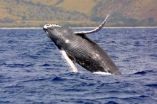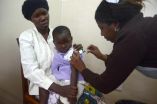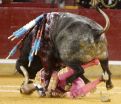(Press-News.org) For better and for worse, human health depends on a cell's motility –– the ability to crawl from place to place. In every human body, millions of cells –are crawling around doing mostly good deeds ––– though if any of those crawlers are cancerous, watch out.
"This is not some horrible sci-fi movie come true but, instead, normal cells carrying out their daily duties," said Florida State University cell biologist Tom Roberts. For 35 years he has studied the mechanical and molecular means by which amorphous single cells purposefully propel themselves throughout the body in amoeboid-like fashion ––absent muscles, bones or brains.
Meanwhile, human cells don't give up their secrets easily. In the body, they use the millions of tiny filaments found on their front ends to push the front of their cytoskeletons forward. In rapid succession the cells then retract their rears in a smooth, coordinated extension-contraction manner that puts inchworms to shame. Yet take them out of the body and put them under a microscope and the crawling changes or stops.
But now Roberts and his research team have found a novel way around uncooperative human cells.
In a landmark study led by Roberts and conducted in large part by his then-FSU postdoctoral associate Katsuya Shimabukuro, researchers used worm sperm to replicate cell motility in vitro –– in this case, on a microscope slide.
Doing what no other scientists had ever successfully done before, Shimabukuro disassembled and reconstituted a worm sperm cell, then devised conditions to promote thecell's natural pull-push crawling motions even in the unnatural conditions of a laboratory. Once launched, the reconstituted machinery moved just like regular worm sperm do in a natural setting –– giving scientists an unprecedented opportunity to watch it move.
Roberts called his former postdoc's signal achievement "careful, clever work" –– and work it did, making possible new, revealing images of cell motility that should help to pinpoint with never-before-seen precision just how cells crawl.
"Understanding how cells crawl is a big deal," Roberts said. "The first line of defense against invading microorganisms, the remodeling of bones, healing wounds in the skin and reconnecting of neuronal circuits during regeneration of the nervous system –– all depend on the capacity of specialized cells to crawl.
"On the downside, the ability of tumor cells to crawl around is a contributing factor in the metastasis of malignancies," he said. "But we believe our achievements in this latest round of basic research could eventually aid in the development of therapies that target cell motility in order to interfere with or block the metastasis of cancer."
Funding for Robert's worm-sperm study came from the National Institutes of Health. The findings are described in a paper ("Reconstitution of Amoeboid Motility In Vitro Identifies a Motor-Independent Mechanism for Cell Body Retraction") published online in the journal Current Biology.
Why worm sperm?
For one thing, said Roberts, the worm sperm is different from most cells in that itdoesn't use molecular motor proteins to facilitate its contractions; it shimmies along strictly by putting together and tearing down its tiny filaments. And the simple worm sperm makes a good model because, while it is similar to a human cell it has fewer moving parts, making it less complicated to take apart and reassemble than, say, brain or cancer cells.
Armed with the newfound ability to reconstitute amoeboid motility in vitro, cell biologists such as Roberts may be able to learn the answers to some major moving questions. Among them: How can some cells continue to crawl even after researchers have disabled their supply of myosin, the force-producing "mover protein" that functions like a motor to help power muscle and cell contraction?
For Roberts and his team, the next move will be to determine if what they've learned about worm sperm also applies to more conventional crawling cells, including tumor cells.
"As always, there will be more questions," Roberts said. "Are there multiple mechanisms collaborating to drive cell body retraction? Is there redundancy built into the motility systems?"
INFORMATION:
Co-authors of the Current Biology paper include Roberts, a professor in the FSU Department of Biological Science; Shimabukuro, a former FSU postdoctoral associate in biology who now is a research scientist at the Japan Science and Technology Agency; Naoki Noda, of the Marine Biological Laboratory at Woods Hole, Mass.; and Murray Stewart, of the Medical Research Council's Laboratory of Molecular Biology in Cambridge, England.
Cells are crawling all over our bodies, but how?
Biologists at Florida State devise new way to watch how cells move
2011-10-19
ELSE PRESS RELEASES FROM THIS DATE:
New, higher estimates of endangered humpback whales in the North Pacific
2011-10-19
Scientists have increased the estimate on the number of humpback whales in the North Pacific Ocean in a paper published in the journal Marine Mammal Science. The increase follows a refined statistical analysis of data compiled in 2008 from the largest whale survey ever undertaken to assess humpback whale populations throughout the North Pacific.
The number of North Pacific Humpback Whales in the 2008 study known as the Structure of Populations, Levels of Abundance and Status of Humpbacks, or SPLASH, was estimated at just under 20,000 based on a preliminary look at the ...
Charles G. Alvarez Named Chief Financial Officer of Girl Scouts of California's Central Coast
2011-10-19
Girl Scouts of California's Central Coast today announced the appointment of Charles G. Alvarez as Chief Financial Officer. With over 30 years in financial management, Mr. Alvarez has held a number of executive-level financial positions in the Silicon Valley and will now be responsible for the long-term business and financial strategies of the council.
"We are thrilled that Mr. Alvarez will be bringing his breadth of financial management experience to the council," said Sherry Sybesma, Chief Executive Officer of Girl Scouts of California's Central Coast. "His ...
Heart failure hospital stays drop by 30 percent
2011-10-19
Being hospitalized for heart failure (HF) was about 30 percent less likely in 2008 than in 1998, according to a study by Yale physicians in the Oct. 19 issue of JAMA. The team also found that the rate of hospitalization for black men dropped at a lower rate, and that one-year mortality rates declined slightly during this period, but remained high.
Led by Jersey Chen, M.D., assistant professor of internal medicine at Yale School of Medicine, the study examined data from 55,097,390 fee-for-service Medicare beneficiaries hospitalized in the United States and Puerto Rico ...
Relationships more important than genetic ties when deciding who cares for aging family, study finds
2011-10-19
COLUMBIA, Mo. – America's elderly population will nearly double by 2050, according to a Pew Research report. As baby boomers enter retirement, concern exists as to who will care for them as they age. Traditionally, children have accepted the caregiving responsibilities, but those caregiving roles are becoming blurred as more families are affected by divorce and remarriage than in previous decades. Now, University of Missouri researchers have found that relationship quality trumps genetic ties when determining caregiving obligations.
Lawrence Ganong, a professor and co-chair ...
Top 40 Wine Retailers Weigh in on Trends; Napa Technology Survey Shows Retailers Adding Tasting to Aisles and Profits
2011-10-19
Napa Technology, developer of the WineStation Intelligent Preservation and Dispensing System, commissioned a survey of 40 top wine retailers nationwide on wine purchasing trends and best practices for increasing bottle sales.
Respondents agreed that today's consumers are willing to pay more, when given the opportunity to sample wine before they buy. And those retailers willing to look outside the wine bottle for creative and technologically innovative solutions are seeing the profits pour in.
The survey found that 76 percent of retailers agree that wine buying customers ...
Georgia Tech turns iPhone into spiPhone
2011-10-19
It's a pattern that no doubt repeats itself daily in hundreds of millions of offices around the world: People sit down, turn on their computers, set their mobile phones on their desks and begin to work. What if a hacker could use that phone to track what the person was typing on the keyboard just inches away?
A research team at Georgia Tech has discovered how to do exactly that, using a smartphone accelerometer—the internal device that detects when and how the phone is tilted—to sense keyboard vibrations and decipher complete sentences with up to 80 percent accuracy. ...
UCSF study finds steroids could help heal some corneal ulcers
2011-10-19
A UCSF study gives hope to those suffering from severe cases of bacterial corneal ulcers, which can lead to blindness if left untreated. The use of topical corticosteroids in a randomized controlled trial was found to be neither beneficial nor harmful in the overall patient population in the study. However, it helped patients who had more serious forms of bacterial corneal ulcers, according to UCSF researchers.
In a paper published this month in the Archives of Ophthalmology, one of the JAMA/Archives journals, researchers found significant vision improvement—one and a ...
Malaria vaccine candidate, RTS,S reduces the risk of malaria by half in African children
2011-10-19
CHAPEL HILL, N.C. — First results from a large-scale Phase III trial of RTS,S*, published online today in the New England Journal of Medicine (NEJM), show the malaria vaccine candidate to provide young African children with significant protection against clinical and severe malaria with an acceptable safety and tolerability profile. The results were announced today at the Malaria Forum hosted by the Bill & Melinda Gates Foundation in Seattle, Washington.
Half the world's population is at risk of malaria. The disease is responsible for close to 800,000 deaths each year, ...
Spanish Bullfighting Season Ends with Blinded Matador
2011-10-19
Book Espana has found that there are 693 active matadors in Spain during the 2011 bullfighting season and 2582 aspiring matadors. It appears the amount of bullfighters has increased slightly in 2011 compared to 2010, even if bullfighting in Barcelona has ended recently, mainly due to political reasons.
This year Spain has held 648 traditional bullfights, 130 bullfights with the matador riding on a horseback and 1070 bullfights with younger bulls. It appears about 12 500 bulls has been killed in Spanish bullfights during the 2011 season, while zero matadors has been killed ...
Analyzing the sheep genome for parasite resistance
2011-10-19
Genetic resistance to a parasitic nematode that infects sheep has been discovered by a team of scientists with the U.S. Department of Agriculture (USDA) and the International Livestock Research Institute (ILRI).
The researchers are the first to detect quantitative trait loci (QTL), genetic locations on chromosomes, for resistance to gastrointestinal nematode parasites in a double-backcross population derived from African native sheep. The parasites, common in tropical regions, cause significant economic and production losses in Africa each year. Sheep infected with parasites ...
LAST 30 PRESS RELEASES:
Duke and Duke-NUS’ joint cross-population research to uncover "East-West" differences in disease and care
Scientists to ‘spy’ on cancer- immune cell interactions using quantum technology breakthrough
Tech savvy users have most digital concerns
Making lighter work of calculating fluid and heat flow
Normalizing blood sugar can halve heart attack risk
Lowering blood sugar cuts heart attack risk in people with prediabetes
Study links genetic variants to risk of blinding eye disease in premature infants
Non-opioid ‘pain sponge’ therapy halts cartilage degeneration and relieves chronic pain
AI can pick up cultural values by mimicking how kids learn
China’s ecological redlines offer fast track to 30 x 30 global conservation goal
Invisible indoor threats: emerging household contaminants and their growing risks to human health
Adding antibody treatment to chemo boosts outcomes for children with rare cancer
Germline pathogenic variants among women without a history of breast cancer
Tanning beds triple melanoma risk, potentially causing broad DNA damage
Unique bond identified as key to viral infection speed
Indoor tanning makes youthful skin much older on a genetic level
Mouse model sheds new light on the causes and potential solutions to human GI problems linked to muscular dystrophy
The Journal of Nuclear Medicine ahead-of-print tip sheet: December 12, 2025
Smarter tools for peering into the microscopic world
Applications open for funding to conduct research in the Kinsey Institute archives
Global measure underestimates the severity of food insecurity
Child survivors of critical illness are missing out on timely follow up care
Risk-based vs annual breast cancer screening / the WISDOM randomized clinical trial
University of Toronto launches Electric Vehicle Innovation Ontario to accelerate advanced EV technologies and build Canada’s innovation advantage
Early relapse predicts poor outcomes in aggressive blood cancer
American College of Lifestyle Medicine applauds two CMS models aligned with lifestyle medicine practice and reimbursement
Clinical trial finds cannabis use not a barrier to quitting nicotine vaping
Supplemental nutrition assistance program policies and food insecurity
Switching immune cells to “night mode” could limit damage after a heart attack, study suggests
URI-based Global RIghts Project report spotlights continued troubling trends in worldwide inhumane treatment
[Press-News.org] Cells are crawling all over our bodies, but how?Biologists at Florida State devise new way to watch how cells move




